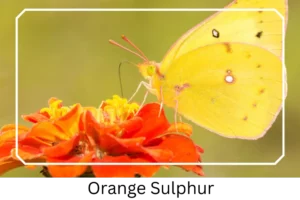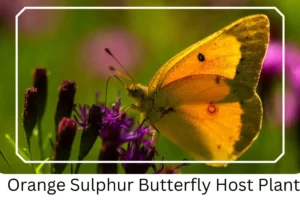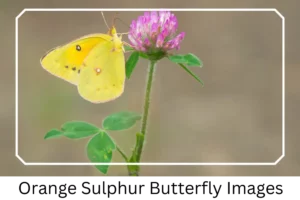Orange Sulphur (Colias eurytheme)
The Orange Sulphur Butterfly, a gem within the North American butterfly fauna, captivates with its bright appearance and modest size. Flourishing across open terrains, this species showcases a fascinating lifecycle and ecological role. Despite their widespread presence from early spring to late fall, their numbers ebb and flow with the seasons, painting landscapes with their vivid hues.
Scientific Classification
- Family: Pieridae
- Genus: Colias
- Common names: Alfalfa Butterfly
- Scientific Name: Colias eurytheme
Overview
Belonging to the vast and vibrant butterfly family, the Orange Sulphur (Colias eurytheme) stands out for its striking coloration and dynamic life stages. This butterfly’s journey from a tiny egg to a fluttering adult encapsulates the intricate balance of nature, highlighting its interaction with various plant species, including the economically significant alfalfa.
Description and Identification
Caterpillar
The larva of the Orange Sulphur embarks on its life feasting on young leaves of host plants under the cover of night. Sporting a green body adorned with rugged textures, it features two prominent yellow to bright white lines along its sides, complemented by fine dots in cyan and black. Its predilection for alfalfa renders it a pest in the eyes of farmers.
Pupa
Camouflaged among dead leaves, the chrysalis adopts a light green hue, accented with a yellow lateral line and intricate brown markings, a master of disguise awaiting metamorphosis.
Adult Butterfly
Sexual Dimorphism: The distinction between males and females is pronounced, with males sporting solid black wing borders and females displaying yellow spots in their stead.
Color and Appearance: In flight, the adults reveal a dazzling yellow, with hints of orange, bordered by black. At rest, the underwing presents a more subdued yellow-orange with a subtle pattern of spots, including a characteristic double spot at the wing’s center.
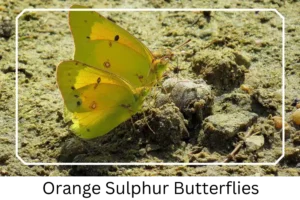
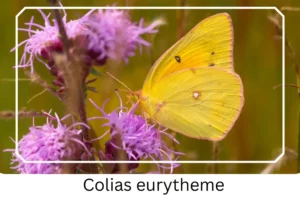 Average Wingspan: The wingspan ranges from 2.5 to 3.3 inches, a testament to its delicate yet robust structure.
Average Wingspan: The wingspan ranges from 2.5 to 3.3 inches, a testament to its delicate yet robust structure.
Flight Pattern: Characterized by its fast and erratic flight, the Orange Sulphur is a lively participant in the ecosystem’s daily dance.
Eggs
Laid individually, the initially white eggs undergo a remarkable transformation, turning red after a few days, signaling the start of a new generation.
Quick Facts | |
| Distribution | Across North America, from southern Canada to Mexico, excluding the central and southeastern US. |
| Habitat | Prefers open areas such as roadsides and agricultural lands. |
| Lifespan of Adults | Ranges from 2 to 4 weeks on average. |
| Host Plants | Favors the pea family (Fabaceae), especially alfalfa (Medicago sativa). |
| Adult Diet | Primarily nectar from various flowers |
How to Identify Orange Sulphur Butterfly?
Identifying the Orange Sulphur Butterfly amidst the plethora of butterfly species can be an engaging endeavor. Look for its bright yellow or occasionally white females, distinct wing borders, and the unique double spot on the wing’s underside. Observing its flight pattern, a fast and somewhat haphazard fluttering, can also aid in identification. The presence of these butterflies in open areas, especially near roadsides and agricultural lands, is a clue to their identification. Notably, the variation in color and appearance due to sexual dimorphism adds an intriguing layer to recognizing this species. By paying attention to these details, enthusiasts and casual observers alike can enjoy the delightful experience of spotting an Orange Sulphur in the wild.
Did You Know?
- In addition to their common yellow variant, some females exhibit a rare white coloration.
- The species earns the nickname “Alfalfa Butterfly” due to its special affinity for alfalfa plants, a key aspect of both its common and scientific names.
- The Orange Sulphur’s larvae have been observed to play a role in controlling alfalfa weevil populations, a pest to the same crops they are often found on.
Conclusion
The Orange Sulphur Butterfly, with its vivid hues and fascinating lifecycle, is more than just a beautiful spectacle. It plays a significant role in the ecosystem, pollinating plants and contributing to the agricultural landscape, despite the challenges it presents as a pest. By understanding and appreciating the intricate details of its existence, we gain insight into the complex interplay of nature’s myriad creatures, underscoring the importance of conserving the delicate balance of our environment.
Orange Sulphur Pictures

Scientific Classification

- Family: Pieridae
- Genus: Colias
- Common names: Alfalfa Butterfly
- Scientific Name: Colias eurytheme

